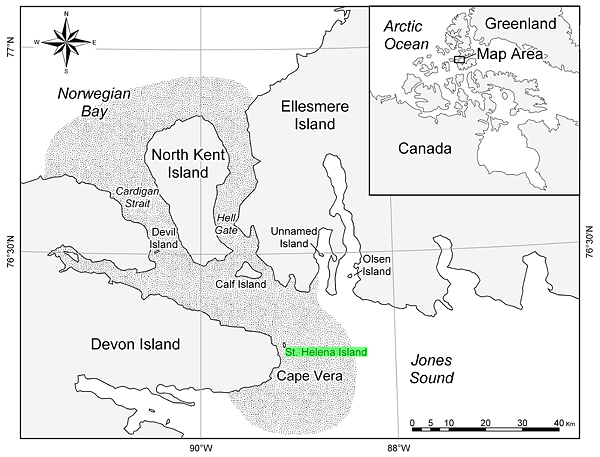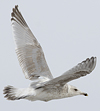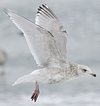 Thayer's Gull (thayeri)
Thayer's Gull (thayeri)
(last update: January 22, 2013)
Thayer's Gull 4cy (3rd cycle) / sub-adult February
Apparent Survival of Adult Thayer's and Glaucous Gulls Nesting Sympatrically in the Canadian High Arctic
BY: Karel A. Allard, H. Grant Gilchrist, André R. Breton, Cynthia D. Gilbert
IN: Ardea 01-2011.
ABSTRACT:
We estimated apparent survival of 33 adult Thayer's Gulls Larus thayeri and 21 adult Glaucous Gulls Larus hyperboreus nesting sympatrically at a small colony on St. Helena Island, Nunavut, in Canada's high Arctic, using five consecutive years (2003–2007) of capture-mark-resight data. Resighting probabilities were high in all years for both species (0.97). Mean survival for Thayer's (0.81 ± 0.05) was low, but for Glaucous Gulls (0.86 ± 0.05) was comparable to estimates of survival reported for large gulls elsewhere. Both species showed high annual variation in survival, with one year each of noticeably lower survival, suggesting that some factors acting on survival may have differed between species and could reflect different species' exposure to natural or anthropogenic stressors. Our findings contribute to the limited demographic information on these polar gulls, and provide a basis for future comparisons should they be affected by changes in their polar environments.

Fig. 1. Map of the typical Hell Gate Polynya configuration (stippled region) in mid July, including key islands surveyed for marine bird colonies. The floe edge is found where the stippled and white regions meet. FROM: Marine birds of the Hell Gate Polynya, Nunavut, Canada, by: Mark L. Mallory & H. Grant Gilchrist.
 Thayer's Gull 3rd cycle (4CY), February 14 2014, Lake County Fairground, Libertyville, IL. Picture: Maarten van Kleinwee.
Thayer's Gull 3rd cycle (4CY), February 14 2014, Lake County Fairground, Libertyville, IL. Picture: Maarten van Kleinwee. Thayer's Gull 3rd cycle (4CY), February 15 2014, North Point Marina, Winthrop Harbor, IL. Picture: Maarten van Kleinwee.
Thayer's Gull 3rd cycle (4CY), February 15 2014, North Point Marina, Winthrop Harbor, IL. Picture: Maarten van Kleinwee. Thayer's Gull sub-adult, February 15 2014, North Point Marina, Winthrop Harbor, IL. Picture: Maarten van Kleinwee.
Thayer's Gull sub-adult, February 15 2014, North Point Marina, Winthrop Harbor, IL. Picture: Maarten van Kleinwee. Thayer's Gull sub-adult, February 11 2012, Pelagic off Lewes, DE. Picture: Adrian Hinkle.
Thayer's Gull sub-adult, February 11 2012, Pelagic off Lewes, DE. Picture: Adrian Hinkle. Thayer's Gull sub-adult, February 26 2012, Lake County, IL. Picture: Amar Ayyash.
Thayer's Gull sub-adult, February 26 2012, Lake County, IL. Picture: Amar Ayyash. Thayer's Gull sub-adult, February 20 2010, Winthrop Harbor, IL. Picture: Erik Bruhnke.
Thayer's Gull sub-adult, February 20 2010, Winthrop Harbor, IL. Picture: Erik Bruhnke. Thayer's Gull sub-adult, February 20 2010, Winthrop Harbor, IL. Picture: Erik Bruhnke.
Thayer's Gull sub-adult, February 20 2010, Winthrop Harbor, IL. Picture: Erik Bruhnke. Thayer's Gull sub-adult, February 03 2013, Boulder County, Colorado. Picture: Amar Ayyash.
Thayer's Gull sub-adult, February 03 2013, Boulder County, Colorado. Picture: Amar Ayyash.